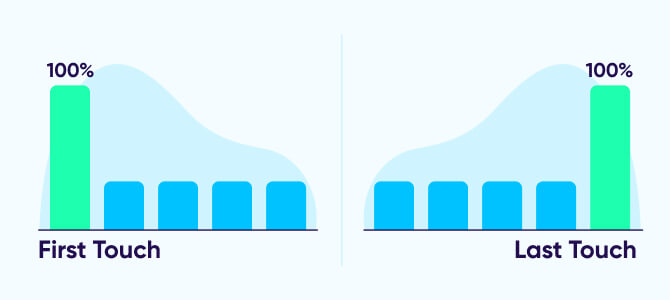
Attribution modeling
Attribution modeling is a way of measuring how effective marketing campaigns and channels are at influencing people to take a desired action (such as making a purchase).
What is attribution modeling?

Attribution modeling is a way of measuring the impact of different marketing efforts across the customer journey, so that advertisers can assess which channels or campaigns are most effective in driving conversions.
As they engage with a brand, users are exposed to various marketing touchpoints — both paid and organic — which can influence them to take a particular action (installing an app or making a purchase, for example). Attribution models analyze interactions with these touchpoints, and work out their contribution to the decision-making process.
Attribution modeling can be single-touch, analyzing the effectiveness of a single click, or multi-touch. Multi-touch attribution models (MTAs) help marketers understand how consumers make decisions across multiple brand engagements over time.
Why is attribution modeling important?
Attribution modeling gives marketers vital insight into what’s working and what’s not in their campaigns. If you don’t understand where your leads and sales are coming from, you may continue to invest in ineffective channels and lose out on potential revenue.
What are the benefits of using attribution models?
When you understand which campaigns are driving user engagement, you can double down on what’s working and increase your ROI. Let’s take a closer look at some of the benefits of attribution modeling.
1. Better resource allocation
Attribution modeling helps you allocate your marketing resources more efficiently. You can shift budget and effort away from underperforming channels, reducing waste, and towards those that have a higher ROI and greater impact on conversions.
2. Agile decision-making
Attribution modeling helps you make smart, data-driven decisions about your marketing efforts in real time, so you don’t waste a cent of your budget. Instead of making decisions at the start of a campaign and assessing monthly or quarterly, you can test and adjust messaging quickly based on immediate results. Some tools can even A/B test content and automate allocation based on results.
3. Personalization

With cross-device tracking, you can understand the customer’s previous interactions and behaviors. Use these insights to create personalized marketing experiences, leading to more engaged, loyal users and increasing the chances of conversion.
What are the different attribution models?
There isn’t just one attribution model to assess your campaign’s effectiveness – there are many.
Because each customer’s journey can involve multiple touchpoints in the buying process, marketers need to decide which touchpoints have the most influence on the conversion.
Single-touch attribution
The simplest attribution methods are single-touch — in other words, they measure the impact of one particular touchpoint in the customer journey.
First-click (or first-touch) attribution assigns the credit for each conversion to the first interaction the customer had with a brand, like clicking on an ad or social media content. Last-click (last-touch) attribution, on the other hand, credits the last interaction before the conversion.

For example, let’s say a user discovers a product through an organic Google search and later makes a purchase after clicking on a paid advertising banner. A first-click attribution model would attribute the conversion entirely to the organic search, ignoring the influence of the paid ad. A last-click attribution model would attribute the conversion entirely to the ad, ignoring the influence of the earlier touchpoints like organic search.
While first-click and last-click attribution provide straightforward ways to assign credit, they can oversimplify the customer journey by ignoring other interactions and touchpoints that may have played a crucial role in the conversion process.
Multi-touch attribution (MTA) models
MTA models, such as cross-channel or time-decay attribution, aim to provide a more holistic view of how different marketing channels contribute to conversions by considering multiple touchpoints along the customer journey. These models can offer a more nuanced understanding of the customer’s path to conversion and help you allocate resources more effectively across various channels.
Here’s an overview of the different attribution models and how they work:
| Attribution model | How it works | Examples |
| First-click | Assigns credit based on the initial touchpoint that introduced the user to the brand or product | First visit to a website or interaction with a social media post |
| Last-click | Assigns credit based on the final interaction the user has with the brand or product | An email sequence during a demo period resulting in a conversion |
| Multi-touch (MTA) | Considers all touchpoints across the conversion journey | Multiple ads appearing over a period of time |
| Cross-channel | Measures the effectiveness of various marketing channels and touchpoints in a customer’s journey, including online and offline influences | Content appearing across a variety of channels, including ads, organic search, social media, and email marketing |
| Linear | Assigns equal weight to all touchpoints along the customer journey | Equal credit for a social media post, a website visit, and a remarketing ad |
| Time decay | Gives more weight to touchpoints that occur closer to the time of conversion | If a buying journey takes 10 days, assign 10% credit to touchpoints in days 0-4, 30% credit for days 5-8, and 60% for days 9-10 |
| U-shaped | Assigns more weight to the first and last interactions, with credit distributed evenly to the intermediate touches | Give 40% credit to the first touch, 40% to the last touch, and distribute the remaining 20% across the middle interactions |
| W-shaped | Assigns more weight to the first and last interactions as well as a lead consideration or post-purchase step | Give 30% credit to the first touch, 30% to the last touch, and distribute the remaining credit among intermediate touches such as signing up for an email newsletter |
What are the challenges of attribution modeling?
Attribution modeling is a powerful tool for marketing teams, but putting it into practice can be complex.
Industry changes, particularly in the area of privacy, are posing challenges for attribution modeling and eroding the data available to companies. Overcoming these challenges requires a combination of technology, data governance, and ongoing refinement of attribution methodologies to better align with evolving customer behavior and business goals.
These are the top four attribution challenges facing marketers today — along with some possible solutions:
Data accuracy
Since attribution modeling relies heavily on data, inaccurate or incomplete data can lead to misattribution. Ensuring that data sources are clean, reliable, and consistent can be a significant challenge.
Solution: Put data governance in place in your company to apply best practices and expertise. Make sure you have a trained data analyst on your team, or ask an internal or external consultant to audit your data collection processes.
Data integration
MTA and cross-channel models can provide a more accurate picture of how marketing efforts contribute to conversions because they acknowledge the complexity of the customer journey. However, integrating data from these disparate sources can be complicated: data needs to flow seamlessly from multiple sources and be properly mapped to customer journeys.
Solution: A UK report found that two-thirds of marketers don’t believe they have the right tools to support cross-channel attribution. To help you, work with an analytics platform like AppsFlyer that specializes in data integration across channels.
Cross-device tracking
According to an eMarketer report, cross-device tracking is the second-largest (42%) attribution challenge for marketers. Customers often switch between devices ( like desktop, mobile, and tablet) during their journeys. Tracking these cross-device interactions accurately can be challenging, as cookies and identifiers may not always work seamlessly across devices.

Solution: Implement AdTech solutions that recognize users based on identifying factors like email address, matching IDs, or cookies.
Privacy and compliance
Stringent regional privacy regulations such as GDPR and CCPA limit what user data you can collect and use. Apple’s ATT framework and Google’s plans to eliminate cookies also restrict what data you can track.
Solution: Rely more heavily on first-party data, such as directing users to your website or app or incentivizing them to opt in as a subscriber. You can also start using privacy sandboxes to proactively address this problem in mobile advertising.
How to choose the right attribution model for your business
Just as customers can take more than one journey to find your product, there’s more than one right way to measure attribution. When it comes to choosing an attribution model, the first decision you need to make is between single-touch and multi-touch attribution.
An MMA report found that a majority (53%) of companies used multi-touch attribution models in 2022. Companies that use MTAs are more satisfied (70%) with their ability to measure the effectiveness of marketing spend than those that don’t (42%). Most MTA users (63%) are better able to immediately apply their learnings, versus those using single-touch (51%).
While MTA has clear benefits, it remains more difficult and more expensive to implement. Many companies remain in an adoption phase, with only 27% of companies saying they’re at full MTA deployment.
If you decide to go down the MTA route, you need to select a specific model such as linear, W-shaped, or U-shaped attribution. You should choose a model that aligns with your company’s goals, data availability, and understanding of customers’ behavior.
Here are four factors to consider:
The customer journey
How complex is your product and buying journey? A widely-recognized consumer product will have a completely different customer journey than a B2B service or software with multiple steps and decision-makers.

Sales cycle
How long or short is your sales cycle? U-shaped attribution is good for measuring short sales cycles, while W-shaped or linear models may capture the nuances of longer cycles.
Offline factors
If offline advertising such as direct mail, TV, or out-of-home still forms an important part of your marketing strategy, MTA will paint a limited picture. While you may be able to collect some data relating to these channels, you’ll need to consider if it’s possible to integrate it with online data.
Company size and resources available
Of course, staffing and budget will always play a role in decision-making. Small companies may not have the skill or time in house to implement MTA. They also may not have the budget to invest in agencies, adtech, or comprehensive measurement tools. However, the more you can measure, the easier it will be to demonstrate marketing ROI and make wise use of shoestring budgets.
How to measure results
As we’ve covered, there’s a range of approaches and tools available to measure attribution. Whether you want an out-of-the-box solution or complete customization, here are three ways you can measure and attribute results for your campaigns:
Google Analytics 4 (GA4)
GA4 is the most popular web analytics tool on the market. A free tool, it can integrate data from both websites and apps, and from paid and organic campaigns. Features include multi-channel funnels and attribution reports that offer insights into how different marketing channels and touchpoints contribute to conversions. The default attribution model on GA4 is “last interaction” (last-touch), but you can switch to several alternatives.
While GA4 is a powerful tool, integrating GA4 with non-Google tools and platforms can pose a challenge.
Third-party attribution
When integrating data from a variety of sources, a third-party attribution system can be valuable. These are external tools, platforms, or services that give a more independent and comprehensive view of your marketing performance. For example, a third-party attribution tool can seamlessly integrate real-time analytics from multiple advertising sources. Look for features like cross-channel tracking, deep linking and in-app analytics, audience segmentation, and fraud detection.
Creating your own tool with Python
If you’re looking for a custom analytics tool, you could choose to build your own in Python. Building a custom tool is a complex undertaking, but is possible with the right knowledge and tools. A developer will need to collect and prepare the data, choose an attribution model, process the tool through a Python library, and apply the model to the data with visualization and custom reporting.
Key takeaways
- Attribution modeling is a way of measuring the impact of marketing activities across the customer journey. The models analyze customer interactions with various touchpoints, and work out how much each has contributed to the conversion.
- Effective attribution modeling shows marketers what’s working and what’s not. It offers insights that enable better decision-making, resource allocation, and personalization.
- The key challenges marketers have to overcome with attribution modeling are data accuracy and integration, cross-device tracking, and privacy concerns.
- While multi-touch attribution (MTA) gives a fuller picture than single-touch, it’s more complex to implement.
- There is no one-size-fits-all solution to attribution modeling. Consider your sales cycle and customer journey, resources, and goals when choosing a model.
- Consider your overall marketing mix and strategy when choosing an attribution tool. Depending on your needs and resources, you can opt for a free, out-of-the-box tool, a third-party provider, or a DIY approach.



